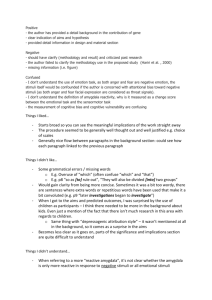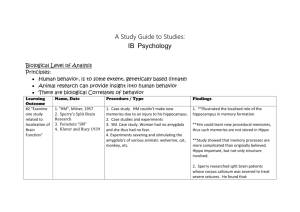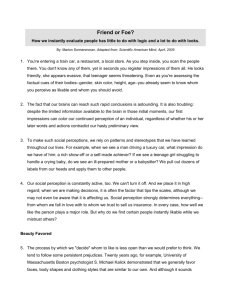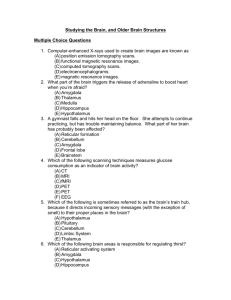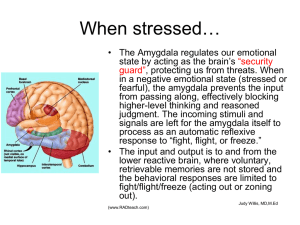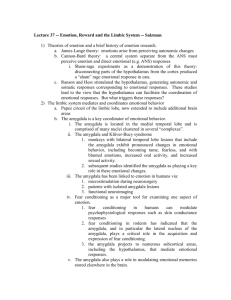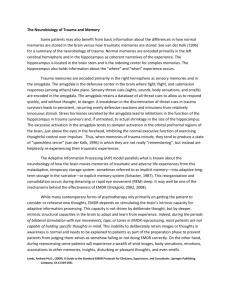Cognitive Neuroscience of Emotion Cognitive Emotional Interactions
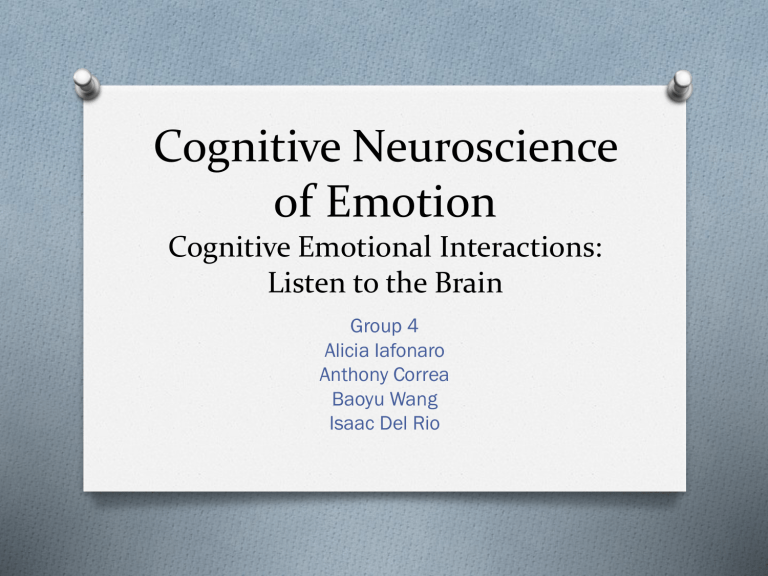
Cognitive Neuroscience of Emotion
Cognitive Emotional Interactions:
Listen to the Brain
Group 4
Alicia Iafonaro
Anthony Correa
Baoyu Wang
Isaac Del Rio
What is fear and how is the
Amygdala involved?
O
O
O
An unpleasant emotion caused by the belief that someone or something is dangerous, likely to cause pain, or a threat.
The amygdala plays a critical role in linking external stimuli to defense responses.
Influence the Basal forebrain cholinergic system, brainstem cholinergic system and the locus cerouleus noradrenergic system
(which supplies norepinephrine throughout the central nervous system).
Cont. Fear and Amygdala
O
O
O
Recent fMRI studies in humans have found that the human amygdala shows activity changes during conditioning (LaBar et al., 1998; Morris,
1998) and these correlate with activity in the thalamus.
Contextual fear conditioning and requires both the amygdala and hippocampus.
Influence the Basal forebrain cholinergic system, brainstem cholinergic system and the locus cerouleus noradrenergic system (which supplies norepinephrine throughout the central nervous system).
Fear and Perception & Attention
Amygdala and Sensory Cortex
O
O
O
The amygdala receives input from cortical sensory processing regions of each sensory modality.
The Amygdala is activated by a sensory event from the thalamus or cortex determine if immediate stimuli poses a threat to well being.
Orchestrate behavioral response, associated autonomic and endocrine reactions that increase the likelihood of surviving the danger.
Situated Emotion
O
O
Function of hippocampus It is important in forming new memories and connecting emotions and senses, such as smell and sound, to these memories.
Bidirectional communication between amygdala and Hippocampus: The amygdala can modulate both the encoding and the storage of hippocampaldependent memories. The hippocampal complex, by forming episodic representations of the emotional significance and interpretation of events, can influence the amygdala response when emotional stimuli are encountered.
Cont. Thinking, memory and plasticity
O
O
HM in 1953 was subjected to surgery in an effort to relieve his epileptic seizures in which he lost his hippocampus, amygdala and part of his parahippocampal gyrus.
He could acquire new skills but had no memory of having acquired them.
Thinking, Memory, Plasticity
O The top left brain slice shows a sagittal brain slice with the hippocampus highlighted in yellow and the amygdala in turquoise, while the top right brain image shows an axial slice
(with the hippocampus again highlighted in yellow and the amygdala in turquoise). The bottom left brain picture shows a coronal slice with the amygdala in turquoise and the hippocampus in yellow.
Perception and Attention Toward Fear
Stimuli
• Once the amygdala receives sensory information from the cortical areas and thalamus, it can determine if the stimuli presents a potential danger.
• The amygdala can then control the input it receives by projecting back to the earliest stages of cortical sensory processing.
• Thus, the amygdala can regulate cortical attention/perceptual processing.
Neural circuits that might underlie social anxiety
O Possible neural circuitry of social anxiety may reside in the hippocampus cortex as it forms and retains contextual fear associations.
How do we know that context is an important part of fear conditioning experiments? What does this have to do with hippocampus? With the amygdala?
O
O
O
If a rat is conditioned to expect a footshock in the presence of a tone in a conditioning chamber, when the rat is placed back into the chamber, it will exhibit fear reactions not only to the tone
CS but also to the conditioning chamber itself, even in the absence of the tone.
The role of context in conditioned associations has been increasingly recognized as an important factor contributing to this form of emotional learning and memory.
Hippocampus contributes to the formation and retention of contextual fear associations --
Connection between the hippocampal formation and the amygdala -- these pathways may provide the initial engagement of emotional reactions to contextual cues and the imparting of emotional meanings to contexts.
Transports short term memory to long term memory.
Discuss what memory systems in the brain may each be responsible for, and how they work together.
O Information about stimuli associated with painful and otherwise unpleasant experiences is stored through the amygdala and related brain regions – this system mediates the emotional reactions elicited when these stimuli are reencountered.
O Implicit or unconscious level – “emotional memories” – amygdala
O Explicit or conscious level – “memories about emotions” – mediated by the medial temporal lobe memory system involving the hippocampus, rhinal cortex, and related cortical areas.
Emotion and Memory
O
O
Implicit and Explicit memory with emotion involved
Amygdala and MTL
Meaning and Fear
O
O
Conditioning and Prepared leaning
Regulating role of VLPFC
From Fear Reaction to Action
O
O
O
Avoidance-conditioning procedures
Emotional reaction and Emotional action
Cortico-Striatal-Amygdala Interactions
Working Memory, Consciousness, and Subjective Feelings
O
O
O
O
O
O
O
The last but not the least
Process view and Consciousness in neuroscience
Structuralism and Functionalism
Working memory: DLPFC
Connections:
DLPFC with Sensory processing, MTL, ACC, OFC
Amygdala: emotional experience
Fear and Amygdala
O
O
What use is fear? Why might the amygdala have evolved?
It must first determine whether immediately present stimuli pose a threat to well-being, and if potential threat is present, the amygdala must then orchestrate behavioral responses and associated autonomic and endocrine reactions that increase the likelihood of surviving the danger
